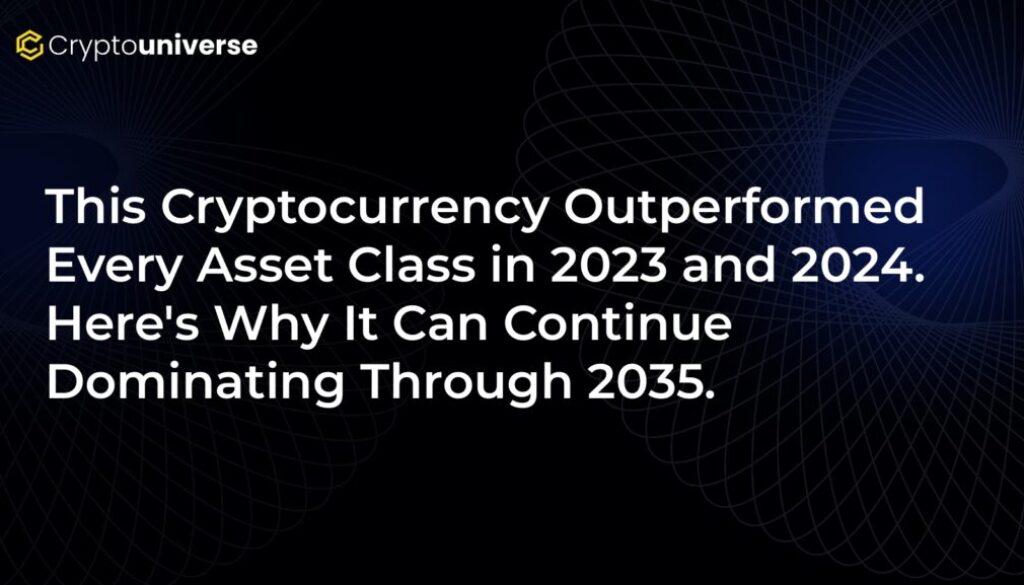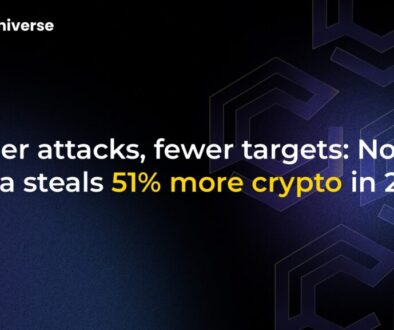This Cryptocurrency Outperformed Every Asset Class in 2023 and 2024. Here’s Why It Can Continue Dominating Through 2035.

The Undisputed Champion of Investment Returns
The last couple of years have been a fantastic ride for investors across the board. In 2023 and 2024, nearly every major asset class delivered positive returns. The S&P 500 surged, rewarding stock investors with total returns of 26% and 25% respectively. Goldbugs saw their holdings shine, growing over 90% since early 2023. Even the typically steady U.S. bond market held its ground, posting respectable gains.
Yet, amidst this sea of green, one asset didn’t just win; it completely dominated. Bitcoin (BTC) delivered staggering returns of 156% in 2023 and another 121% in 2024. While these gains followed a punishing 65% drop in 2022, the recovery has been nothing short of spectacular. The reality is that
Now, with a market capitalization hovering over $2.2 trillion, many investors wonder if the best days are behind us. Can an asset this large continue to produce such explosive growth? While triple-digit annual returns may become rarer, a powerful combination of factors suggests Bitcoin is poised to continue outperforming most, if not all, other asset classes well into the next decade.
Catalyst 1: The Institutional Wave is Just Beginning
For years, the biggest barrier to large-scale investment in Bitcoin was the lack of regulated, accessible financial products. That all changed with the introduction of spot Bitcoin Exchange-Traded Funds (ETFs). These vehicles are a game-changer, allowing institutional investors, wealth managers, and pension funds to gain exposure to Bitcoin through their standard brokerage accounts.
The floodgates are just starting to open. In a short period, Bitcoin ETFs have already attracted over $170 billion in assets. But this is likely just the tip of the iceberg. Leading asset management firms project that even a modest 1% allocation of all institutional assets into Bitcoin could inject another $2.2 trillion into the market by 2035. This influx of capital alone could nearly double Bitcoin’s current price.
This trend is supported by a rapidly maturing regulatory landscape. As governments around the world provide clearer rules for owning and trading digital assets, the perceived risk for large institutions diminishes, making a strategic allocation to Bitcoin not just possible, but prudent.
Catalyst 2: The Rise of ‘Digital Gold’
Beyond institutional speculation, the most powerful long-term driver for Bitcoin’s value is its growing acceptance as a premier store of value—a modern-day digital gold.
What does this mean? In an era of persistent government budget deficits and expanding national debt, the long-term value of traditional fiat currencies like the U.S. dollar is under pressure. This economic reality pushes investors to seek out assets that can protect their wealth from inflation and currency debasement. For centuries, that asset was gold.
Today, Bitcoin presents a compelling digital alternative. Here’s why:
- Absolute Scarcity: Unlike gold, where higher prices can incentivize more mining and increase supply, Bitcoin’s supply is mathematically fixed. There will only ever be 21 million BTC. This verifiable scarcity is its most powerful feature.
- Digital Portability: You can move billions of dollars worth of Bitcoin across the globe in minutes with minimal fees, a feat impossible with physical gold.
- Divisibility: A single Bitcoin can be divided into 100 million smaller units (satoshis), making it accessible for transactions of any size.
Analysts predict the total market for inflation-hedge assets could more than triple by 2035. If Bitcoin captures just 25% of that market, its value would soar to nearly $23 trillion. The recent 90% surge in gold’s price shows the demand for safe-haven assets is already high. As more investors recognize Bitcoin’s superior properties, a significant shift of capital from traditional stores of value to digital ones seems inevitable.
Catalyst 3: The Unbreakable Code of Scarcity
Underpinning Bitcoin’s entire value proposition is its unchangeable monetary policy, written into its code. The supply of new Bitcoin entering circulation is cut in half approximately every four years in an event known as the “halving.”
This process systematically reduces the inflation rate of the network. Currently, Bitcoin’s supply is increasing at just 0.8% annually—already lower than that of most commodities. After the next halving in 2028, this will drop to a mere 0.4%. This ever-increasing scarcity, combined with rising demand, creates a powerful upward pressure on its price over the long term.
The Road to 2035: A Bumpy but Bullish Ride
Of course, the path forward will not be a straight line. Bitcoin remains a volatile asset, subject to significant price swings. The broader crypto market is filled with thousands of other projects, some of which may outperform Bitcoin in shorter periods. However, none possess the same combination of decentralization, security, and hard-coded scarcity that makes Bitcoin a unique global asset.
Putting it all together, the case for Bitcoin’s continued dominance is compelling. The combination of surging institutional adoption, a strengthening narrative as the ultimate inflation hedge, and its unshakeable supply dynamics creates a powerful formula for long-term growth. While past performance is no guarantee of future results, the fundamental drivers are stronger than ever, positioning Bitcoin to potentially remain the world’s best-performing asset for years to come.


